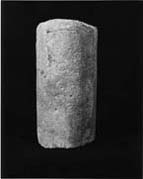Select a site alphabetically from the choices shown in the box below. Alternatively, browse sculptural examples using the Forward/Back buttons.
Chapters for this volume, along with copies of original in-text images, are available here.
Object type: Four fragments of columns or balustershafts [1]
Measurements: Fragment a: H. 21 cm (8.3 in); Diameter 9.5 cm (3.7 in); Fragment b: H. 39.5 cm (15.5 in); Diameter 12 cm (4.7in); Fragment c: H. 18.5 cm (7.6 in); Diameter 11.5 cm (4.5in); Fragment d: H. 29 cm (11.4 in) Diameter 11.5cm (4.5 in).
Stone type: Fragments a, c-d: Hartlepool and Roker dolomite; b: magnesian limestone (marl?)
Plate numbers in printed volume: Pls. 82.421, 83.422-424
Corpus volume reference: Vol 1 p. 96-97
(There may be more views or larger images available for this item. Click on the thumbnail image to view.)
Fragment a: A section of plain shaft.
Fragment b: A section of a shaft with diagonal grooved mouldings.
Fragments c–d: Two sections, possibly of the same shaft, with diagonal grooved mouldings.
Fragment a is of the same stone as c-d, and so could be part of the same fitment or scheme of decoration. The columns are slender and so could hardly have supported a considerable weight. Perhaps, as has been postulated for the Monkwearmouth and Jarrow group, they and b formed part of the baldacchino and surrounding screen of an altar.
Grooved and twisted columns, such as a, b, c and d, are, of course, known in late antique art on the colonnades of sarcophagi, or in architectural forms, and these were copied in Carolingian manuscripts and on ivories, for example, the pyx of Abraham and the Vienna Virgin's pyx (Schnitzler 1965, pls. 92-3), and on book-covers such as the Lorsch Gospels (c. 800), where the Virgin's canopy is composed of segmented columns, the central portions of which are twisted and grooved (ibid., pl. 97). One may remember also the columns with twisted mouldings from the mausoleum at Repton, Derbyshire. It is not so surprising to find reflections of such continental fashions at Hart, when one considers the advanced iconography of cross-head 7.



